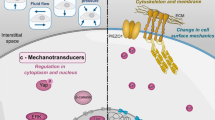Abstract
Purpose
The Adriamycin mouse model (AMM) is a reproducible teratogenic model of esophageal atresia/tracheo-esophageal fistula (EA/TEF). Tbx4 is a member of the T-box family of transcription factor genes, which is reported to play a key role in separation of the respiratory tract and the esophagus. Up-regulation of Tbx4 is reported to cause TEF in the chick. Optical projection tomography (OPT) is a technique that allows three-dimensional (3D) imaging of gene expression in small tissue specimens in an anatomical context. The aim of this study was to investigate the temporo-spatial expression of Tbx4 during the critical period of separation of the trachea and esophagus in normal and Adriamycin treated embryos using OPT.
Materials and methods
Time-mated CBA/Ca mice received intraperitoneal injections of Adriamycin (6 mg/kg) or saline on days 7 and 8 of gestation. Embryos were harvested on days 9–12, stained following whole mount in situ hybridization with labeled RNA probes to detect Tbx4 transcripts (n = 5 for each treatment/day of gestation). Immunolocalization with the endoderm marker Hnf3β was used to visualize morphology. Embryos were scanned by OPT to obtain 3D representations of gene expression domains. Animal licence no. B100/4106.
Results
OPT elegantly revealed Tbx4 gene expression in both controls and in the disorganized pulmonary mesenchyme in the treated embryos. Although characteristic morphological abnormalities were observed in Adriamycin treated embryos, there was no significant difference in Tbx4 transcript distribution around lung primordia in comparison with control embryos.
Conclusion
Although previously reported morphological abnormalities of notochord and esophagus were observed in AMM, Tbx4 gene expression was unaltered, suggesting that esophageal anomalies can occur in the presence of normal Tbx4 gene expression in this model.


Similar content being viewed by others
References
Quan L, Smith DW (1973) The VATER association: vertebral defects, anal atresia, T-E fistula with esophageal atresia, radial and renal dysplasia: a spectrum of associated defects. J Pediatr 82:104–107
Temtamy SA, Miller JD (1974) Extending the scope of the VATER association: definition of the VATER syndrome. J Pediatr 85:345–349
Khoury MJ, Cordero JF, Greenberg F, James LM, Erickson JD (1983) A population study of the VACTERL association: evidence for its etiologic heterogeneity. Pediatrics 71:815–820
Diez-Pardo JA, Qi B, Navarro C, Tovar JA (1996) A new rodent experimental model of esophageal atresia and tracheoesophageal fistula: preliminary report. J Pediatr Surg 31:498–502
Ioannides AS, Chaudhry B, Henderson DJ, Spitz L, Copp AJ (2002) Dorsoventral patterning in oesophageal atresia with tracheo-oesophageal fistula: evidence from a new mouse model. J Pediatr Surg 37:185–191
Dawrant M, Giles S, Bannigan J, Puri P (2007) Adriamycin mouse model: a variable but reproducible model of tracheo-oesophageal malformations. Pediatr Surg Int 23:469–472
Chapman DL, Garvey N, Hancock S, Alexiou M, Agulnik SI, Gibson-Brown JJ, Cebra-Thomas J, Bollag RJ, Silver LM, Papaioannou VE (1996) Expression of the T-box family genes, Tbx1–Tbx5, during early mouse development. Dev Dyn 206:379–390
Sakiyama J, Yamagishi A, Kuroiwa A (2003) Tbx4-Fgf10 system controls lung bud formation during chicken embryonic development. Development 130:1225–1234
Ang SL, Wierda A, Wong D, Stevens KA, Cascio S, Rossant J, Zaret KS (1993) The formation and maintenance of the definitive endoderm lineage in the mouse: involvement of HNF3/forkhead proteins. Development 119:1301–1315
Ang SL, Rossant J (1994) HNF-3 beta is essential for node and notochord formation in mouse development. Cell 78:561–574
Sharpe J, Ahlgren U, Perry P, Hill B, Ross A, Hecksher-Sorensen J, Baldock R, Davidson D (2002) Optical projection tomography as a tool for 3D microscopy and gene expression studies. Science 296:541–545
Summerhurst K, Stark M, Sharpe J, Davidson D, Murphy P (2008) 3D representation of Wnt and Frizzled gene expression patterns in the mouse embryo at embryonic day 11.5 (Ts19). Gene Expr Patterns 8(5):331–348
Costa RH, Kalinichenko VV, Lim L (2001) Transcription factors in mouse lung development and function. Am J Physiol Lung Cell Mol Physiol 280:L823–L838
Merei JM, Hutson JM (2002) Embryogenesis of tracheo-esophageal anomalies: a review. Pediatr Surg Int 18:319–326
Maeda Y, Dave V, Whitsett JA (2007) Transcriptional control of lung morphogenesis. Physiol Rev 87:219–244
Litingtung Y, Lei L, Westphal H, Chiang C (1998) Sonic hedgehog is essential to foregut development. Nat Genet 20:58–6139
Que J, Choi M, Ziel JW, Klingensmith J, Hogan BL (2006) Morphogenesis of the trachea and esophagus: current players and new roles for noggin and Bmps. Differentiation 74(7):422–437
Naito Y, Kimura T, Aramaki M, Izumi K, Okada Y, Suzuki H, Takahashi T, Kosaki K (2009) Caudal regression and tracheoesophageal malformation induced by adriamycin: a novel chick model of VATER association. Pediatr Res 65:607–612
Hajduk P, Murphy P, Puri P (2009) Fgf10 gene expression is delayed in the embryonic lung mesenchyme in the adriamycin mouse model. Pediatr Surg Int 26:23–27
Lioubinski O, Alonso MT, Alvarez Y, Vendrell V, Garrosa M, Murphy P, Schimmang T (2006) FGF signalling controls expression of vomeronasal receptors during embryogenesis. Mech Dev 123(1):17–23
Sato H, Murphy P, Giles S, Bannigan J, Takayasu H, Puri P (2008) Visualizing expression patterns of Shh and Foxf1 genes in the foregut and lung buds by optical projection tomography. Pediatr Surg Int 24:3–11
Author information
Authors and Affiliations
Corresponding author
Rights and permissions
About this article
Cite this article
Hajduk, P., Murphy, P. & Puri, P. Mesenchymal expression of Tbx4 gene is not altered in Adriamycin mouse model. Pediatr Surg Int 26, 407–411 (2010). https://doi.org/10.1007/s00383-010-2580-y
Accepted:
Published:
Issue Date:
DOI: https://doi.org/10.1007/s00383-010-2580-y




